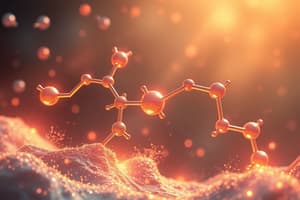Podcast
Questions and Answers
Which statement accurately describes the solubility of alkenes?
Which statement accurately describes the solubility of alkenes?
- Alkenes are insoluble in organic solvents but soluble in water.
- Alkenes are equally soluble in both water and organic solvents.
- Alkenes are insoluble in water but soluble in organic solvents. (correct)
- Alkenes are highly soluble in water due to their polar nature.
How does branching affect the boiling point of alkenes, and why?
How does branching affect the boiling point of alkenes, and why?
- Branching increases the boiling point due to increased molecular weight.
- Branching increases the boiling point due to increased surface contact.
- Branching decreases the boiling point due to reduced surface contact. (correct)
- Branching has no effect on the boiling point of alkenes.
What is the primary reason alkenes are more reactive than alkanes?
What is the primary reason alkenes are more reactive than alkanes?
- Alkenes have a higher degree of saturation.
- Alkenes have lower molecular weights.
- Alkenes possess a pi (π) bond, creating a region of high electron density. (correct)
- Alkenes have weaker carbon-carbon single bonds.
Which type of isomerism is characterized by different spatial arrangements of atoms in alkenes, but the same connectivity?
Which type of isomerism is characterized by different spatial arrangements of atoms in alkenes, but the same connectivity?
What condition is essential for an alkene to exhibit cis-trans isomerism?
What condition is essential for an alkene to exhibit cis-trans isomerism?
According to the Cahn-Ingold-Prelog (CIP) priority rules, what signifies a Z isomer?
According to the Cahn-Ingold-Prelog (CIP) priority rules, what signifies a Z isomer?
What type of reaction is characteristic of alkenes due to the presence of the pi (π) bond?
What type of reaction is characteristic of alkenes due to the presence of the pi (π) bond?
In the context of alkene reactions, what does Markovnikov's rule predict?
In the context of alkene reactions, what does Markovnikov's rule predict?
What is the outcome of the peroxide effect in the addition of HBr to an alkene?
What is the outcome of the peroxide effect in the addition of HBr to an alkene?
What type of product is formed when an alkene reacts with a peroxyacid (e.g., m-CPBA)?
What type of product is formed when an alkene reacts with a peroxyacid (e.g., m-CPBA)?
What is the primary type of reaction used in the synthesis of alkenes?
What is the primary type of reaction used in the synthesis of alkenes?
What type of catalyst is typically used in the dehydration of alcohols to synthesize alkenes?
What type of catalyst is typically used in the dehydration of alcohols to synthesize alkenes?
What does Zaitsev's rule predict regarding the major product in dehydrohalogenation reactions?
What does Zaitsev's rule predict regarding the major product in dehydrohalogenation reactions?
In the Wittig reaction, what type of compound reacts with an aldehyde or ketone to form an alkene?
In the Wittig reaction, what type of compound reacts with an aldehyde or ketone to form an alkene?
What is the major product in Hofmann elimination reactions?
What is the major product in Hofmann elimination reactions?
Which of the following industrial applications directly utilizes ethene (ethylene)?
Which of the following industrial applications directly utilizes ethene (ethylene)?
Which polymer is produced from propene (propylene)?
Which polymer is produced from propene (propylene)?
What role do alkenes play in the synthesis of pharmaceuticals and agrochemicals?
What role do alkenes play in the synthesis of pharmaceuticals and agrochemicals?
Which of the following reactions is used to hydrate alkenes in an anti-Markovnikov fashion?
Which of the following reactions is used to hydrate alkenes in an anti-Markovnikov fashion?
What products are typically formed in the ozonolysis of an alkene followed by reduction?
What products are typically formed in the ozonolysis of an alkene followed by reduction?
Flashcards
Alkenes
Alkenes
Hydrocarbons containing one or more carbon-carbon double bonds, also known as olefins.
General formula for alkenes
General formula for alkenes
CₙH₂ₙ is the formula for alkenes with one double bond.
Polarity of Alkenes
Polarity of Alkenes
Nonpolar compounds due to similar electronegativity of carbon and hydrogen.
Alkene Boiling Points
Alkene Boiling Points
Signup and view all the flashcards
Reactivity of Alkenes
Reactivity of Alkenes
Signup and view all the flashcards
Structural Isomers
Structural Isomers
Signup and view all the flashcards
Stereoisomers
Stereoisomers
Signup and view all the flashcards
Cis-Trans Isomerism
Cis-Trans Isomerism
Signup and view all the flashcards
Cis Isomers
Cis Isomers
Signup and view all the flashcards
Trans Isomers
Trans Isomers
Signup and view all the flashcards
Z Isomer
Z Isomer
Signup and view all the flashcards
E Isomer
E Isomer
Signup and view all the flashcards
Addition Reactions
Addition Reactions
Signup and view all the flashcards
Hydrogenation
Hydrogenation
Signup and view all the flashcards
Hydration
Hydration
Signup and view all the flashcards
Markovnikov's Rule
Markovnikov's Rule
Signup and view all the flashcards
Peroxide Effect
Peroxide Effect
Signup and view all the flashcards
Dehydration of Alcohols
Dehydration of Alcohols
Signup and view all the flashcards
Dehydrohalogenation
Dehydrohalogenation
Signup and view all the flashcards
Zaitsev's Rule
Zaitsev's Rule
Signup and view all the flashcards
Study Notes
- Alkenes are hydrocarbons containing one or more carbon-carbon double bonds.
- They are also known as olefins.
- The general formula for alkenes with one double bond is CₙH₂ₙ.
Properties of Alkenes
- Alkenes are nonpolar compounds due to the similar electronegativity of carbon and hydrogen.
- Physical properties are similar to alkanes with the same number of carbon atoms.
- Alkenes are insoluble in water but soluble in organic solvents.
- Alkenes exhibit van der Waals forces.
- Boiling points increase with increasing molecular weight due to increased van der Waals forces.
- Branched alkenes have lower boiling points compared to straight-chain alkenes due to reduced surface contact.
- Alkenes are more reactive than alkanes due to the presence of the pi (π) bond.
- The double bond is a region of high electron density, making alkenes susceptible to electrophilic attack.
Isomerism in Alkenes
- Alkenes exhibit both structural and stereoisomerism.
- Structural isomers have the same molecular formula but different arrangements of atoms.
- Stereoisomers have the same connectivity but different spatial arrangements.
- Geometric isomerism (cis-trans isomerism) occurs in alkenes due to restricted rotation around the double bond.
- Cis isomers have substituents on the same side of the double bond.
- Trans isomers have substituents on opposite sides of the double bond.
- Cis-trans isomerism requires that each carbon of the double bond must have two different groups attached.
- The Cahn-Ingold-Prelog (CIP) priority rules are used to assign E/Z configurations to alkenes.
- If the higher priority groups are on the same side of the double bond, it is the Z isomer (from German zusammen, meaning together).
- If the higher priority groups are on opposite sides of the double bond, it is the E isomer (from German entgegen, meaning opposite).
Alkene Reactions
- Alkenes undergo addition reactions in which atoms or groups of atoms add to the carbon-carbon double bond.
- Electrophilic addition is a characteristic reaction of alkenes.
- Common electrophilic addition reactions include:
- Hydrogenation: Addition of hydrogen (H₂) across the double bond in the presence of a metal catalyst (e.g., Pt, Pd, Ni).
- Halogenation: Addition of halogens (e.g., Cl₂, Br₂) across the double bond.
- Hydrohalogenation: Addition of hydrogen halides (e.g., HCl, HBr) across the double bond, following Markovnikov's rule.
- Hydration: Addition of water (H₂O) across the double bond in the presence of an acid catalyst (e.g., H₂SO₄).
- Markovnikov's rule states that in the addition of HX to an alkene, the hydrogen atom adds to the carbon with more hydrogen atoms already attached.
- Peroxide effect (anti-Markovnikov addition): In the presence of peroxides, HBr adds to alkenes in an anti-Markovnikov fashion, where the hydrogen atom adds to the carbon with fewer hydrogen atoms.
- Oxymercuration-Demercuration: A reaction sequence used to hydrate alkenes, following Markovnikov's rule, without carbocation rearrangements. It involves the addition of mercury(II) acetate followed by reduction with sodium borohydride.
- Hydroboration-Oxidation: A reaction sequence used to hydrate alkenes in an anti-Markovnikov fashion. It involves the addition of borane (BH₃) followed by oxidation with hydrogen peroxide (H₂O₂) and hydroxide (OH⁻).
- Epoxidation: Reaction of an alkene with a peroxyacid (e.g., m-CPBA) to form an epoxide (oxirane).
- Ozonolysis: Reaction of an alkene with ozone (O₃) followed by reduction with zinc or dimethyl sulfide to cleave the double bond and form aldehydes or ketones.
- Polymerization: Alkenes can undergo polymerization to form polymers.
Alkene Synthesis
- Alkenes can be synthesized through various methods, primarily elimination reactions.
- Dehydration of alcohols: Removal of water (H₂O) from an alcohol, typically using an acid catalyst (e.g., H₂SO₄, H₃PO₄) at high temperatures.
- Dehydrohalogenation of alkyl halides: Removal of a hydrogen halide (HX) from an alkyl halide, typically using a strong base (e.g., KOH, NaOH, alkoxides).
- E2 mechanism is favored for dehydrohalogenation.
- Zaitsev's rule states that the major product is the more substituted alkene (the alkene with more alkyl groups attached to the double-bonded carbons).
- Cracking of alkanes: Breaking down large alkane molecules into smaller, more useful alkenes and alkanes at high temperatures.
- Wittig Reaction: Reaction of an aldehyde or ketone with a Wittig reagent (phosphorus ylide) to form an alkene.
- Hofmann Elimination: Elimination reaction of quaternary ammonium hydroxides to form alkenes. The less substituted alkene is the major product (anti-Zaitsev or Hofmann product).
Industrial Applications of Alkenes
- Alkenes are important building blocks in the chemical industry.
- Ethene (ethylene) is used to produce polyethylene, a widely used plastic.
- Propene (propylene) is used to produce polypropylene.
- Alkenes are used in the synthesis of various organic compounds, including alcohols, aldehydes, ketones, and carboxylic acids.
- Alkenes are used as monomers in the production of polymers and as intermediates in the synthesis of pharmaceuticals, agrochemicals, and other fine chemicals.
Studying That Suits You
Use AI to generate personalized quizzes and flashcards to suit your learning preferences.




